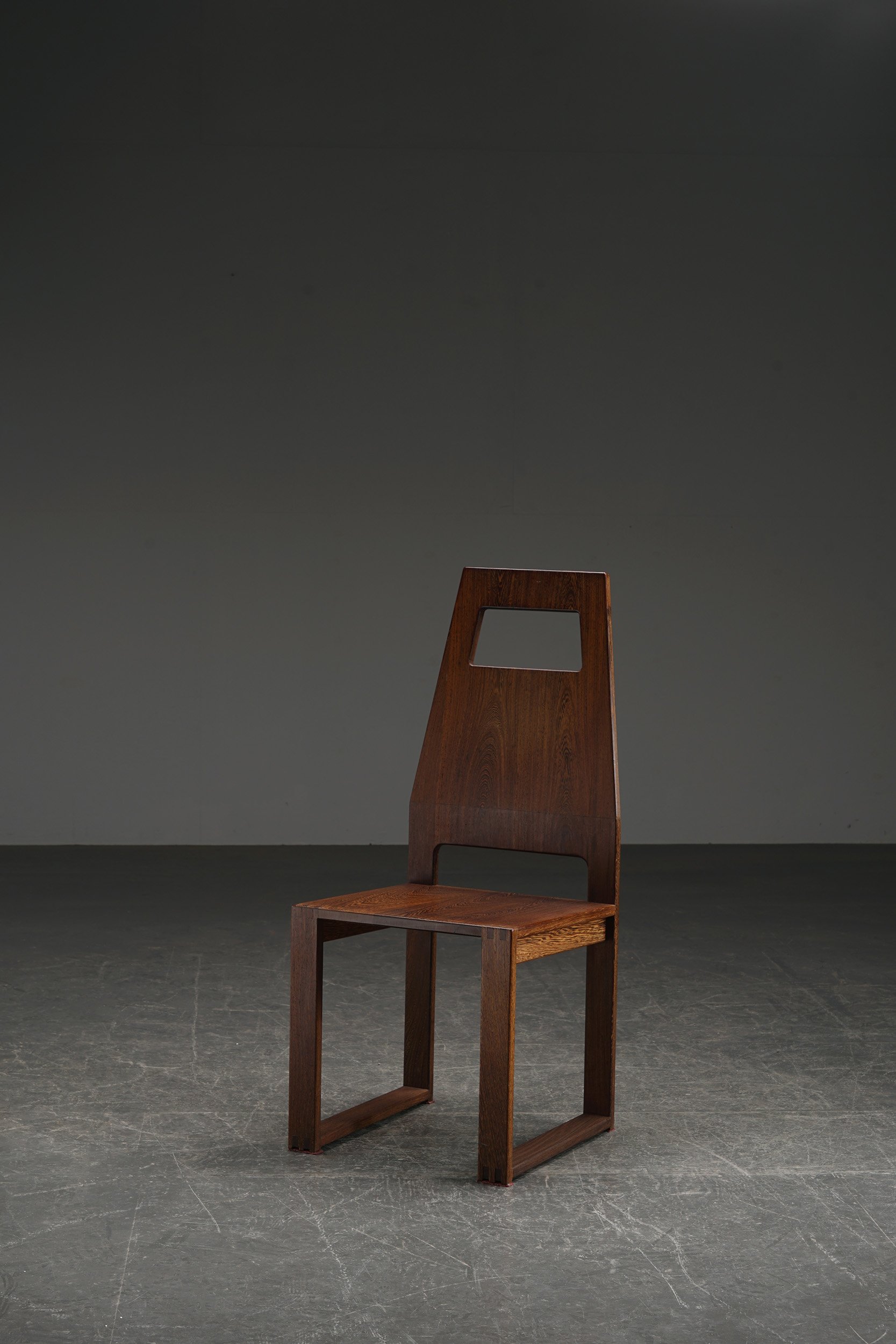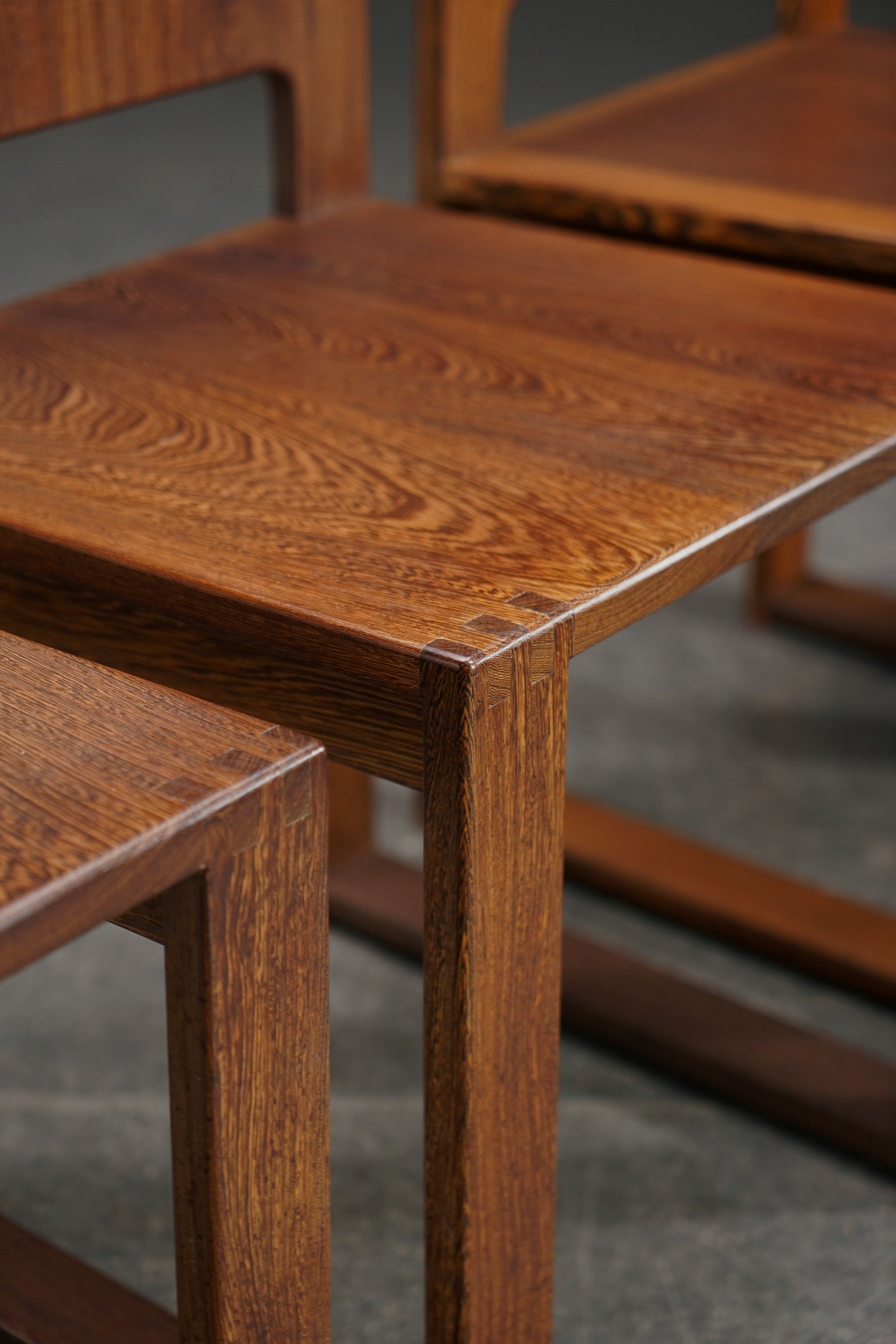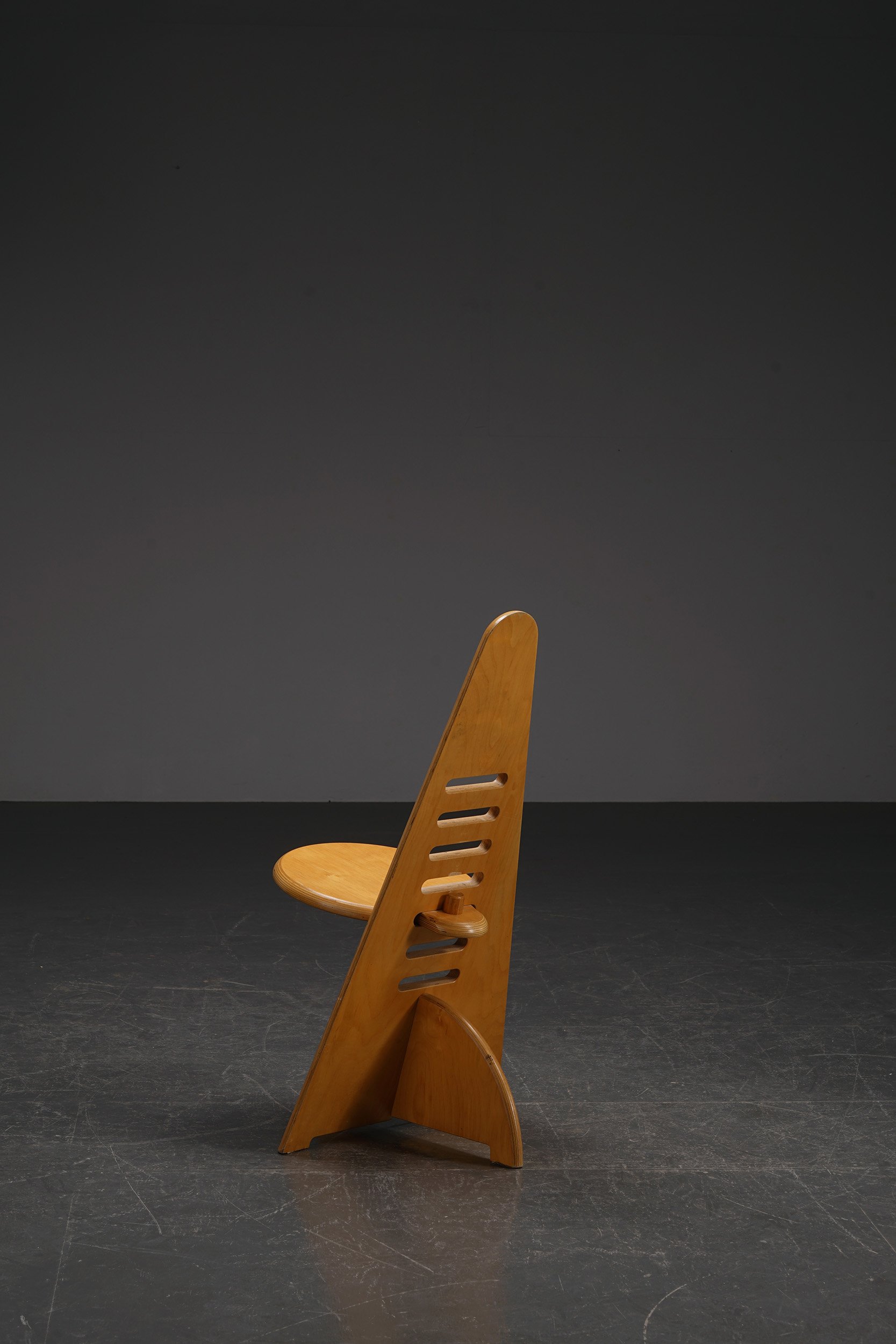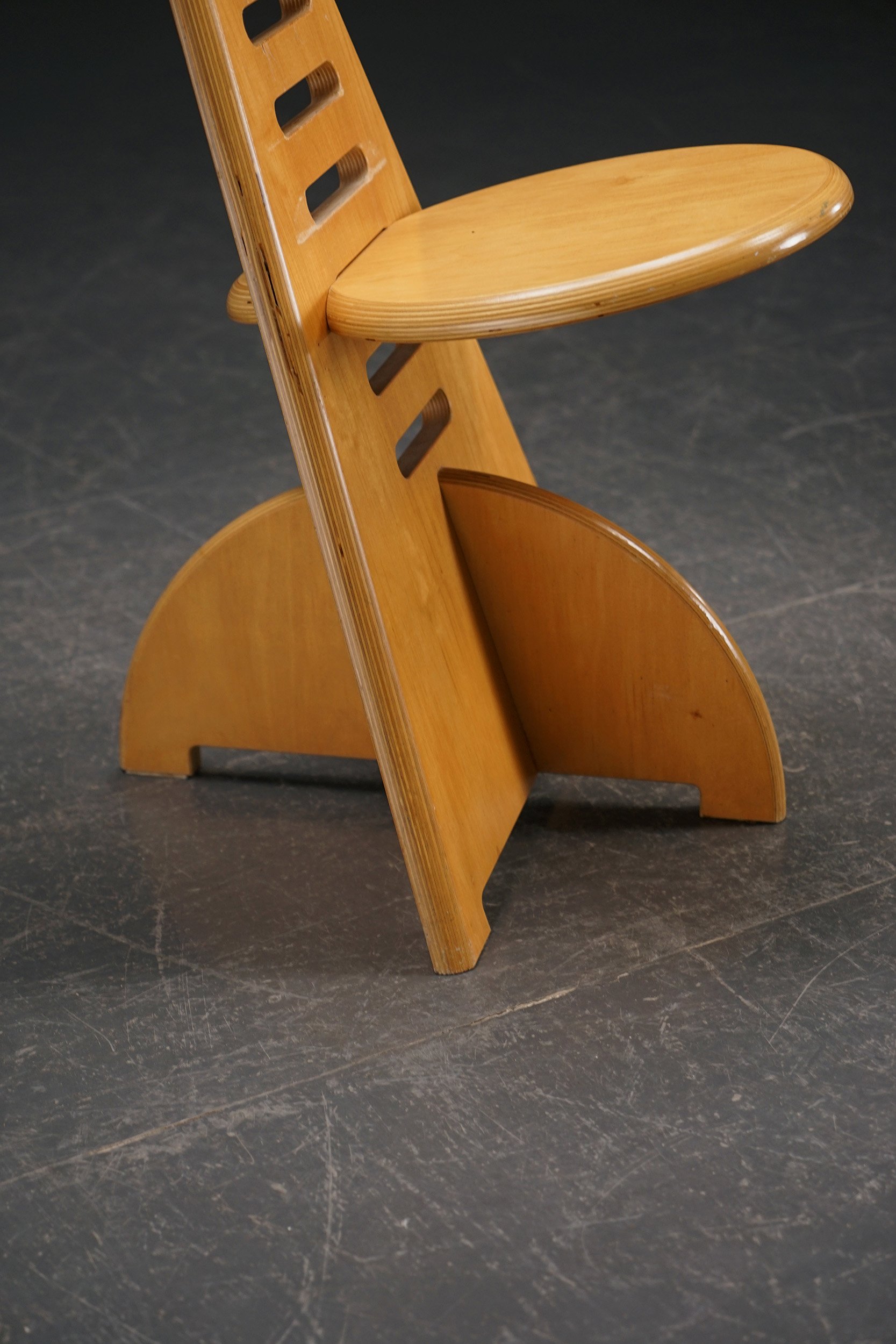Amsterdamse School Chairs by Architect Michel de Klerk
Architect Michel de Klerk (1884-1923)
’t Woonhuys
period: 1916-1917
origin: The Netherlands
dimensions (cm): h108,5 x w50 x d57 cm (sh50 / ar57 cm)
dimensions (inch): h42,72 x w19,69 x d22,44 in (sh19,69 / ar22,44 in)
material: vintage upholstery, wood
Available as set or single chairs.
If you would prefer this piece to be upholstered in a different fabric or colour, please contact us for our upholstery services.
Michel de Klerk (1884-1923) is undoubtably the most prominent architect of Amsterdamse School, an architectural movement that took flight in the Netherlands around 1910.
Dynamic slopes, spikes, angles, and decoration: thanks to the many (not uncontroversial) ties between Indonesia and Netherlands at the time, the Amsterdamse School movement was strongly inspired by Indonesian culture and famed for its exuberant expressiveness.
Michel de Klerk’s best kept designs were made for furniture firm ‘t Woonhuys. He was known as a ‘genius of form’, and the eccentric details adorning his designs are of unparalleled originality and fantastic. You’d almost wonder whether to call his work furniture or sculpture.
These chairs were designed in 1916-1917 for a dining room. Having spent his youth poor and hungry, the almost skeleton-like features in Michel de Klerk’s designs may be seen as symbolizing ribcages and spines in memory of his skin-over-bone childhood. Consequently, sitting in a chair by his hand is in a way strangely satisfying for both the seated one as the chair itself, beckoning to be ‘filled’, and marvellously comfortable.
A number of these same chairs are part of the design collection of Centraal Museum Utrecht and currently on view at Musée d'Orsay in Paris.
Source:
Michel de Klerk: Bouw- En Meubelkunstenaar (1884-1923); Frans van Burkom; Uitgeverij 010 Publishers: Rotterdam, 1990.
Archive photo:
Wonen in de Amsterdamse School: Ontwerpen voor het interieur 1910-1930; Ingeborg de Roode en Marjan Groot; THOTH Publishers: Bussum, 2016.
Architect Michel de Klerk (1884-1923)
’t Woonhuys
period: 1916-1917
origin: The Netherlands
dimensions (cm): h108,5 x w50 x d57 cm (sh50 / ar57 cm)
dimensions (inch): h42,72 x w19,69 x d22,44 in (sh19,69 / ar22,44 in)
material: vintage upholstery, wood
Available as set or single chairs.
If you would prefer this piece to be upholstered in a different fabric or colour, please contact us for our upholstery services.
Michel de Klerk (1884-1923) is undoubtably the most prominent architect of Amsterdamse School, an architectural movement that took flight in the Netherlands around 1910.
Dynamic slopes, spikes, angles, and decoration: thanks to the many (not uncontroversial) ties between Indonesia and Netherlands at the time, the Amsterdamse School movement was strongly inspired by Indonesian culture and famed for its exuberant expressiveness.
Michel de Klerk’s best kept designs were made for furniture firm ‘t Woonhuys. He was known as a ‘genius of form’, and the eccentric details adorning his designs are of unparalleled originality and fantastic. You’d almost wonder whether to call his work furniture or sculpture.
These chairs were designed in 1916-1917 for a dining room. Having spent his youth poor and hungry, the almost skeleton-like features in Michel de Klerk’s designs may be seen as symbolizing ribcages and spines in memory of his skin-over-bone childhood. Consequently, sitting in a chair by his hand is in a way strangely satisfying for both the seated one as the chair itself, beckoning to be ‘filled’, and marvellously comfortable.
A number of these same chairs are part of the design collection of Centraal Museum Utrecht and currently on view at Musée d'Orsay in Paris.
Source:
Michel de Klerk: Bouw- En Meubelkunstenaar (1884-1923); Frans van Burkom; Uitgeverij 010 Publishers: Rotterdam, 1990.
Archive photo:
Wonen in de Amsterdamse School: Ontwerpen voor het interieur 1910-1930; Ingeborg de Roode en Marjan Groot; THOTH Publishers: Bussum, 2016.
Architect Michel de Klerk (1884-1923)
’t Woonhuys
period: 1916-1917
origin: The Netherlands
dimensions (cm): h108,5 x w50 x d57 cm (sh50 / ar57 cm)
dimensions (inch): h42,72 x w19,69 x d22,44 in (sh19,69 / ar22,44 in)
material: vintage upholstery, wood
Available as set or single chairs.
If you would prefer this piece to be upholstered in a different fabric or colour, please contact us for our upholstery services.
Michel de Klerk (1884-1923) is undoubtably the most prominent architect of Amsterdamse School, an architectural movement that took flight in the Netherlands around 1910.
Dynamic slopes, spikes, angles, and decoration: thanks to the many (not uncontroversial) ties between Indonesia and Netherlands at the time, the Amsterdamse School movement was strongly inspired by Indonesian culture and famed for its exuberant expressiveness.
Michel de Klerk’s best kept designs were made for furniture firm ‘t Woonhuys. He was known as a ‘genius of form’, and the eccentric details adorning his designs are of unparalleled originality and fantastic. You’d almost wonder whether to call his work furniture or sculpture.
These chairs were designed in 1916-1917 for a dining room. Having spent his youth poor and hungry, the almost skeleton-like features in Michel de Klerk’s designs may be seen as symbolizing ribcages and spines in memory of his skin-over-bone childhood. Consequently, sitting in a chair by his hand is in a way strangely satisfying for both the seated one as the chair itself, beckoning to be ‘filled’, and marvellously comfortable.
A number of these same chairs are part of the design collection of Centraal Museum Utrecht and currently on view at Musée d'Orsay in Paris.
Source:
Michel de Klerk: Bouw- En Meubelkunstenaar (1884-1923); Frans van Burkom; Uitgeverij 010 Publishers: Rotterdam, 1990.
Archive photo:
Wonen in de Amsterdamse School: Ontwerpen voor het interieur 1910-1930; Ingeborg de Roode en Marjan Groot; THOTH Publishers: Bussum, 2016.















































































































